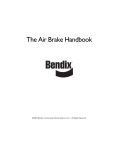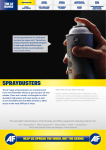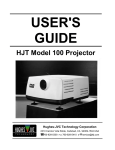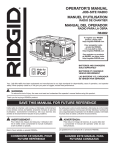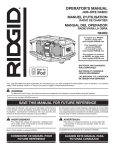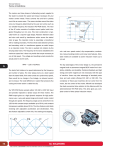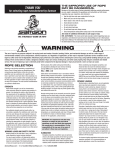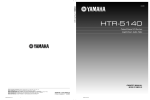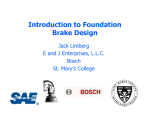Download BENDIX BW1601 User's Manual
Transcript
SD-20-6608 ® Bendix® A2LS™ Hydraulic Drum Brakes w/Parking DIRT SHIELD CROSS-OVER PIPE RETAINING SPRING CROSS-OVER PIPE WHEEL CYLINDER END SHOE RETURN SPRING CAP SCREWS EXPANDER END SHOE RETURN SPRING WHEEL CYLINDER GASKET GROMMETS SHOE HOLD-DOWN CLIP (NOT FITTED TO EARLY BRAKES) EXPANDER FIGURE 1 - A2LS™ AUTOMATIC ADJUSTING TWO LEADING SHOE DRUM BRAKE The A2LS™ drum brake is a hydraulically operated duo-duplex brake with an automatic adjustment and parking brake feature. The A2LS™ drum brake (automatic adjust, two leading shoes) provides two leading shoes in either direction of drum rotation and an automatic adjustment of the brake shoes to compensate for lining wear. The single web brake shoes are located by slots in the wheel cylinder tappet head, the expander input tappet/piston and abutment tappet, and are retained by the shoe return springs. As with all Bendix automatic adjusting brakes, provision is made for manual override of the automatic adjuster. This should only be needed for initial adjustment of the shoes to a specific drum clearance, or to back off shoes to enable a lipped drum to be removed. Both the wheel cylinder unit and expander unit have cast integral brake mounting lugs, each taking the brake torque load. The wheel cylinder unit contains two single acting hydraulic cylinders with automatic adjusters. The expander unit contains a double acting hydraulic cylinder with a park brake wedge expander. Wheel cylinder and expander units have either a 1-5/8 inch (41,3mm) or 1-3/4 inch (44,5mm) diameter bore depending upon vehicle brake requirements. The units are hydraulically connected together with a bridge pipe or crossover tube. The brake assembly incorporates an integral backing plate (dirtshield) to protect the brake from excessive water and dirt intrusion. The backing plate (dirtshield) contains a steady post for each brake shoe to insure that lining material is kept parallel to the drum braking surface. Both brake shoes are free to slide on their abutment faces against the backing plate (dirtshield) and are therefore able to centralize themselves to the drum. Lining material is 3/4 inch (19,11 mm) thick in the center of the shoe tapering to approximately 5/8 inch (15,9 mm) at each end. Lining inspection holes and DESCRIPTION 1 manual override access holes are covered by rubber grommets. INPUT/ TAPPET PISTON WHEEL CYLINDER PISTONS WHEEL CYLINDER PISTONS ROLLER/TAPPET PISTON ABUTMENT TAPPET FIGURE 2 - SERVICE BRAKE APPLICATION OPERATION On brake pedal application, hydraulic fluid pressure is delivered to the wheel cylinder and expander unit. This hydraulic pressure forces the wheel cylinder pistons outwards, Figure 2, moving the brake shoes against the drum. At the same time hydraulic pressure also forces the input tappet piston and abutment tappet in the expander unit outward, moving the opposite end of the brake shoes toward the drum. The expander input tappet/piston pushes against one shoe, and the roller tappet/piston pushes on the expander abutment tappet and through this to the other shoe. (ARROW INDICATES DIRECTION OF DRUM ROTATION) TORQUE LOAD TORQUE LOAD FIGURE 4 - REVERSE DRUM ROTATION When the brake shoe lining contacts the drum the shoes are forced around, sliding on the abutments, in the direction Of drum rotation. In the forward direction, Figure 3, the torque load from one shoe is taken by the wheel cylinder piston bottoming in its bore in the wheel cylinder, and from the opposite shoe by the expander abutment tappet resting against the expander unit body. In the reverse direction, Figure 4, the torque load from one shoe is taken by the other wheel cylinder piston bottoming in its bore in the wheel cylinder, and from the opposite shoe by the expander input tappet/piston head resting against the expander body. In this way, regardless of forward or reverse drum rotation, the brake will always be a two leading shoe brake. PARKING BRAKE APPLICATION On application of the parking brake, the spring actuator screwed into the back of the expander unit housing pushes the wedge assembly forward. As the wedge assembly moves (ARROW INDICATES DIRECTION OF DRUM ROTATION) TORQUE LOAD TORQUE LOAD WEDGE ASSEMBLY FIGURE 3 - FORWARD DRUM ROTATION 2 FIGURE 5 - PARKING BRAKE APPLICATION PISTON SEAL MANUAL OVERRIDE WHEEL DRIVE RING ADJUSTER SPRING ADJUSTER SHAFT HELIX DRIVE RING FIGURE 6 - WHEEL CYLINDER ASSEMBLY CUT-AWAY forward, the wedge rollers force the expander abutment tappet and roller tappet/piston apart, Figure 5, and directly, or through the expander input tappet/piston the brake shoes are forced against the drum. In parking brake operation the brake assembly is a one leading and one trailing shoe brake, in either forward or reverse drum rotation. The adjuster drive ring is held in light contact with its seat in the cylinder body by the drive ring spring. The brake shoe tip engaging in the piston tappet head, and a spring between the adjuster shaft assembly and the face of the adjuster bore, insure that a back-lash is maintained on the mating threads of the adjuster shaft and piston. AUTOMATIC ADJUSTMENT OF BRAKE SHOES When the brake pedal is applied, hydraulic fluid pressure causes the piston to move outwards, lifting the adjuster shaft In the A2LS™ drum brakes, automatic adjustment is controlled by the wheel cylinder units. Adjuster assemblies within the wheel cylinder units control the clearance between the drum and brake shoe by the back-lash built into each adjuster mechanism. During braking application, when no adjustment is required, brake shoe travel takes place within the back-lash available. As the linings wear and the distance between the lining and drum exceeds the predetermined clearance, travel of the piston exceeds the back-lash available and adjustment of the brake shoe is automatically made. Each wheel cylinder piston has an adjuster mechanism screwed into it (Figure 6). The rotation of this adjuster relative to the piston adjusts the brake shoes according to the amount of lining wear. The adjuster shaft has a fast helix thread; onto this is mounted a drive ring having a corresponding thread with an axial clearance (back-lash) built in. AT REST SHOE RETURN SPRING LOAD NORMAL APPLICATION (NO ADJUSTMENT REQUIRED) PISTON AND ADJUSTER (SCREW MOVE OUT) DRIVE RING SEATED ADJUSTER SCREW SEATED DRIVE RING SEATED ADJUSTER SCREW DRIVE RING SPRING LOAD ADJUSTER SCREW DRIVE RING FIGURE 7 - ADJUSTER OPERATION 3 BRAKES HELD ON (DRIVE RING ALREADY SETTLED IN NEW POSITION) BRAKE APPLICATION (ADJUSTMENT REQUIRED) DRIVE RING-LIFTED OFF SEATING-ROTATES RIDES DOWN HELIX AND RE-SEATS DRIVE RING RE-SEATED As the axial tolerance between the adjuster shaft helix and adjuster drive ring is taken up, the load on the drive ring helix forces it onto its seat. The resultant friction keeps it from further rotation. As the piston and adjuster continue through the cylinder, the adjuster shaft helix is forced to rotate through the drive ring. (Figure 9) This rotation of the adjuster shaft, relative to the piston, unscrews the adjuster shaft from the piston, increasing the overall length of the adjuster and piston assembly. This in turn reduces the brake shoe lining to drum clearance. The automatic adjustment rate is variable; each application of the brake takes up only a percentage of the excess shoe to drum clearance. This avoids over adjustment when the drums get hot and expand. Note: Due to manufacturing tolerances, it is unlikely that all brake shoes will run at the same clearances. No detrimental effect will result and no attempt should be made to standardize these clearances. FIGURE 8 - ADJUSTER OPERATION MANUAL OVERRIDE MECHANISM off its seat in the cylinder body. If the movement of the adjuster shaft helix through the adjuster drive ring is less than the axial clearance (back-lash), no rotation of the adjuster shaft takes place. (Figure 7) When the movement of the adjuster shaft helix through the adjuster drive ring is greater than the axial clearance, rotation of the drive ring relative to the adjuster shaft will occur. (Figure 8) As the adjuster shaft helix passes through the drive ring, the drive ring, lightly loaded by the drive ring spring, will rotate in its seat in the cylinder body. As the brake pedal is released, the brake shoe return springs cause the brake shoe to push the piston and adjuster shaft assembly back through the cylinder. BRAKES HELD ON (DRIVE RING ALREADY SETTLED IN NEW POSITION) RETURN STROKE ADJUSTMENT COMPLETED SHOE RETURN SPRING LOAD DRIVE RING RE-SEATED DRIVE RING SEATED The manual override mechanism is used to override the automatic adjuster to set the initial shoe to drum clearance. This initial adjustment is made after new brake shoes have been installed, or other maintenance work has been performed requiring the removal of the brake drum. This adjustment ‘is necessary to avoid excessive movement of the wheel cylinder pistons and to achieve a correct and stabilized running clearance. The manual override is also used to un-adjust the brakes when removing the drum when a lipped drum condition exists. IMPORTANT! PLEASE READ: The manual override should not be used as an alternative to the auto-adjuster. It is essential that the auto-adjust mechanism be kept in good operating condition to insure safe and reliable brake operation. PREVENTIVE MAINTENANCE The A2LS™ drum brakes normally do not require any service except when new linings are being installed. The automatic adjusters eliminate the need for any periodic adjustment of the brakes. To insure safe operation of the brakes, the following service checks should be performed. The following is a recommended time table; the actual times may vary depending upon the use of the vehicle and the type of operation and condition the vehicle is exposed to. LINE HAUL VEHICLES FIGURE 9 - ADJUSTER OPERATION 4 Every 50,000 miles (80,000 km), six months, or 900 operating hours, whichever occurs first, perform the service checks outlined in this manual. CITY DELIVERY Every 15,000 miles (24,000 km), two months, or 300 operating hours, whichever occurs first, perform the service checks outlined in this manual. SERVICE CHECKS With the vehicle on a level surface, block the wheels to prevent movement of the vehicle. 1. Remove one or more of the lining inspection plugs. Check the thickness of the brake linings. 2. Activate the brake pedal. Observe the brake shoes through the inspection holes and make sure that the brake shoes move against the drums smoothly and promptly. Release the brake pedal and make sure the brake shoes retract promptly and smoothly. 3. Apply the parking brake. Observe the brake shoes through the inspection hole and make sure the brake shoes engage the drum. 4. Check all hydraulic fittings and the surface of the backing plate (dirtshield) for any evidence of hydraulic fluid leakage. 5. Refer to the vehicle manual for service checks of other brake related items. WARNING! When working on or around brake systems and components, the following precautions must be observed: WARNING! PLEASE READ AND FOLLOW THESE INSTRUCTIONS TO AVOID PERSONAL INJURY OR DEATH: When working on or around brake systems and components, the following precautions must be observed at all times: 1. Park the vehicle on a level surface, apply the parking brakes, and always block the wheels. When working around or under the vehicle, stop the engine and remove the key from the ignition. Always keep hands away from chambers as they may apply as system pressure drops. Always wear safety glasses. 2. When working in the engine compartment, the engine should be shut off and the ignition key should be removed. Where circumstances require that the engine be in operation, extreme caution should be used to prevent personal injury resulting from contact with moving, rotating, leaking, heated or electrically charged components. 3. Do not attempt to install, remove, disassemble or assemble a component until you have read and thoroughly understand the recommended procedures. Use only the proper tools and observe all precautions pertaining to the use of those tools. 4. Following the vehicle manufacturer’s recommended procedures, deactivate the electrical system in a manner that safely removes all electrical power from the vehicle. 5. If the vehicle is equipped with an air over hydraulic brake system or any auxiliary pressurized air system, make certain to drain the air pressure from all reservoirs before beginning ANY work on the vehicle. If the vehicle is equipped with an AD-IS™ air dryer system or a dryer reservoir module, be sure to drain the purge reservoir. 6. Never connect or disconnect a hose or line containing pressure; it may whip. Never remove a component or pipe plug unless you are certain all system pressure has been depleted. 7. Never exceed manufacturer’s recommended pressure. 8. Never attempt to disassemble a component until you have read and understand all recommended procedures. Some components contain powerful springs and injury can result if not properly disassembled. Use only proper tools and observe all precautions pertaining to use of those tools. 9. Use only genuine Bendix ® replacement parts, components and kits. A. Use only components, devices and mounting and attaching hardware specifically designed for use in hydraulic brake systems. B. All replacement hardware, tubing, hose, fittings, etc. must be of equivalent size, type and strength as the original equipment. 10. Components with stripped threads or damaged parts should be replaced rather than repaired. Do not attempt repairs requiring machining or welding unless specifically stated and approved by the vehicle and component manufacturer. 11. Prior to returning the vehicle to service, make certain all components and systems are restored to their proper operating condition. ADJUSTMENT OPENING FIGURE 10 - REAR VIEW OF THE BACKING PLATE (DIRTSHIELD) 5 REMOVAL BRAKE SHOE REMOVAL The removal, disassembly, cleaning and reassembly instructions presented are primarily for reference. Disassembly, particularly of the wheel cylinders and expanders, should not be attempted without the proper maintenance kits on hand. Damage to some parts may occur as a result of disassembly. Maintenance kits are available from your local authorized Bendix parts outlet. 1. Park the vehicle on a level surface and prevent vehicle movement by a means other than with the parking brake. Shut off engine. 2. Manually cage all hydraulic spring actuators, raise the axle and remove the wheels and tires using the procedure recommended by the vehicle manufacturer ’s maintenance manual. 3. Un-adjust the vehicle brake shoes as follows: A. Remove the rubber grommets from the manual override access holes marked “ADJ” in the backing plate (dirtshield), and insert a blunt screwdriver, or adjusting tool, until it engages the manual override wheel. Refer to Figure 10. B. Using the backing plate (dirtshield) as a fulcrum, Figure 11, turn the override wheel in a CLOCKWISE direction, as viewed from the override wheel end until the lining clears the lip in the drum. Watch the lining through the lining inspection hole, Figure 26. C. Repeat this procedure with the other brake shoe and remove the drum. IMPORTANT: Do not apply service or park brake after drums have been removed. DO NOT ALLOW SPRING END TO ENGAGE INSIDE HOLE FIGURE 12 - SHOE RETURN SPRING REMOVAL SPRING REMOVAL TOOL MADE FROM 0.375 IN. DIA. TOOL STEEL A D E C B A = 3/8 IN. (9.5 mm) B = 1/2 IN. (12.7 mm) C = 0.1 IN. (2.54 mm) D = 0.15 IN. (3.8 mm) E = 0.2 IN. (5 mm) 3/8 IN. DIA. 1/8 IN. THK. 3/4 IN. 1 IN. COUNTER CLOCKWISE TO ADJUST UP CLOCKWISE TO DE-ADJUST 1 IN. FIGURE 11 - ADJUSTING ADJUSTER MECHANISM 6 FIGURE 13 CLOCKWISE TO DE-ADJUST PUSH DOWN 10. Inspect the wheel cylinder unit and expander unit for leaks. Lift the dust boots at their inner diameters from the tappets and pistons. If fluid escapes when the dust boots are lifted, the wheel cylinder or expander must be removed for service. Follow the instructions in this manual for wheel cylinder unit and expander unit removal and service. 11. If there is no evidence of brake fluid leakage in the wheel cylinder unit or expander unit, install new dust boots (if necessary). Refit the tappet head and manual override assembly to the wheel cylinder. Temporarily install an elastic band around the wheel cylinder adjuster pistons to prevent them form becoming displaced. WHEEL CYLINDER AND EXPANDER UNIT REMOVAL 1. Disconnect the hydraulic inlet hose and bridge pipe from the wheel cylinder and expander unit. 2. If the expander unit is being removed at this time, remove the parking brake chamber from the expander body and backing plate (dirtshield). Refer to the vehicle service manual. FIGURE 14 - DE-ADJUSTING ADJUSTER MECHANISM 4. Place the recessed end of a 3/8 inch (9,53 mm) square drive socket extension over the end of the wheel cylinder end shoe return spring, Figure 12. Tap the end of the socket extension until the hook end of the spring passes through the brake shoe web. 5. Shape a length of drill rob, or equivalent tool steel, into a tool as shown in Figure 13. 6. Insert the end of the tool into the loop on the end of the shoe return spring. Using the expander unit body as a fulcrum, unhook the spring from the brake shoe web, Figure 25. Be careful not to damage the rubber dust boot. Note: The brake shoe return spring is hooked into the back side of the shoe web. 7. Ease the shoes from under the shoe hold down clips (where fitted) and remove the back shoes. 8. Remove the tappet head and manual override assemblies from the wheel cylinder units. 9. To rapidly un-adjust the adjusters, fit a piece of 3/4 inch (19,05 mm) heater hose inside a suitable 12 point socket, Figure 14, on either a speedbrace or ratchet drive. Place the heater hose over the piston neck and fully wind back the adjusters as shown in Figure 14. A load must be applied to the wheel cylinder piston while winding back the adjusters. 3. Remove the fixing bolts that secure the wheel cylinder and expander to the backing plate (dirtshield) and remove the units. 4. Move the wheel cylinder and expander to a clean work bench for service. TAPPET HEAD TAPPET HEAD AND MANUAL OVERRIDE WHEEL ASSEMBLY MANUAL OVERRIDE WHEEL DUST BOOT PISTON SEAL ADJUSTER SHAFT ASSEMBLY SPRING & LOCATOR ASSEMBLY GASKET Note: To avoid locking the auto-adjuster mechanism in the fully un-adjusted position, wind out each wheel cylinder piston one complete turn after fully un-adjusting the pistons. FIGURE 15 - WHEEL CYLINDER 7 DISASSEMBLY PIN SPRING FERRULE BRAKE SHOES Bendix brake shoes and linings are available as sets with new factory lining installed. If the brake shoes are in good condition, neither worn nor bent, new lining may be installed on the old brake shoes. For lining installation procedures, and brake shoe inspection procedures, refer to Bendix publication; The Brake Block Manual Part 11, Form No. BW-1257R. WHEEL CYLINDER DISASSEMBLY Before proceeding, clean the exterior of the wheel cylinder and make sure the work area, tools, and hands are clean. Place a clean sheet of paper on the work bench surface. FIGURE 16 - REMOVAL OF PIN FROM WEDGE 1. Clamp the wheel cylinder unit in a bench vise with padded jaws. DUST BOOT INPUT TAPPET/ PISTON RETURN SPRING SPRING & LOCATOR FERRULE PIN HYDRAULIC SEALS ROLLER TAPPET/ PISTON TAPPET SEAL WASHER CIRCLIP (SNAP RING) BLEED SCREW WEDGE SEAL- & RETAINING RING ASSEMBLY WEDGE ASSEMBLY HOUSING STOP PIN GASKET ABUTMENT TAPPET DUST BOOT FIGURE 17 - EXPANDER UNIT 8 2. Remove the tappet head and manual override assembly from the wheel cylinder body, Figure 15. Separate the tappet head from the manual override wheel. Clean all rubber parts that are to be reused with clean DOT 4 heavy duty brake fluid. Place on clean sheet of paper to dry. 3. Using a blunt screwdriver, pry the dust boots from the housing and discard. Inspect all of the parts that are to be reused as outlined below. Replace those parts that are damaged or excessively worn. 4. Carefully blow out both piston assemblies from the cylinder housing using low pressure shop air. Remove the small spring and locator assembly. 5. Unscrew the adjuster shaft assembly from the piston. Note: Do not dismantle the adjuster shaft assembly. 6. Using a small screwdriver, with the end rounded and polished, pry the seal from the piston, taking care not to score the seal groove or piston surface. EXPANDER DISASSEMBLY Before proceeding, clean the exterior of the expander unit and make sure the work area, tools, and hands are clean. Place a clean sheet of paper on the work bench surface. 1. Place the expander unit in a bench vise with padded jaws. 1. Wedge assembly. Check the wedge shaft and wedge surfaces for scoring. Check the rollers for scoring, pits, cracks, and flat spots. Check the roller cage for fatigue cracks. 2. Abutment Tappet. Check the abutment tappet for any nicks, burrs or corrosion. Check the brake shoe web slot for any burrs or damage. Smooth with a fine emery cloth or clean. 3. Tappets/ Pistons. Check the outer surfaces for scoring, pits, or nicks. Check the seal ring and o-ring grooves for any nicks, burrs, or corrosion. Check the brake shoe web slot of the expander input tappet/piston. Check the inside of the piston for damaged threads. Smooth with a fine emery cloth or clean as required. 2. Compress the wedge return spring and remove the pin, Figure 16. Slowly release the spring pressure and remove spring along with the ferrule. 3. Use snap ring pliers to compress and remove the circlip (snap ring), Figure 17. 4. Remove the dust boots from both ends of the expander housing and discard. Note: The dust boots should not be reused and must be replaced. DOT 4 FLUID 5. Remove the abutment tappet, input tappet/ piston and stop pin from the housing. DOT 4 FLUID 6. Remove the wedge assembly, wedge seal, retaining ring assembly and washer. DOT 4 FLUID 7. Push the roller tappet/piston from the housing in the direction of the input tappet/piston, Figure 17. Note: Do not slide the roller tappet/piston past the wedge turret. GREASE 8. Remove the bleed screw. 9. Using a small screwdriver, with the end rounded and polished, pry the seals and o-ring from the input and roller tappet/piston taking care not to score the seal grooves or piston surface. GREASE CLEANING AND INSPECTION Discard all of the old parts that are to be replaced with parts furnished in the repairs kits. Clean all of the metal parts with unused DOT 4 brake fluid or suitable solvent. Do not use gasoline or hot water solution on metal parts. GREASE FIGURE 18 - EXPANDER LUBRICATION POINTS 9 TAPPETS LOCATED OVER WEDGE, CAGE & ROLLER ASSY. 7. Backing Plate (dirtshield). Clean the backing plate with a damp cloth and wire brush to remove any dirt or corrosion from the surface of the backing plate. IMPORTANT! PLEASE READ: STOP PIN FIGURE 19 - EXPANDER TAPPET LOCATION Note: Normal wear pressure marks should not be mistaken for scoring. Some discoloration of the piston diameter may be apparent; this is a normal result of brake actuation over a long period of operation and should be ignored. 4. Adjuster Shaft Assembly. Check for damaged threads. Check the helix for burrs, corrosion, or missing teeth. Check that the adjustment shaft turns easily in the piston for the full length of the threads. Smooth with a fine emery cloth or clean as required. 5. Manual Override. Check the teeth of the manual override for wear or damage. 6. Housings. Examine the cylinder bores for signs of corrosion, ridges, or score marks. Note: Provided the cylinder bore surfaces are in perfect condition, new seals, and if necessary, new pistons may be used to rebuild the existing housings. If there is any doubt as to the condition of the cylinders, new wheel cylinder and expander units must be installed. Do not use an air hose to blow dust out of the backing plate (dirtshield). Never inhale dust from asbestos brake lining. Asbestos dust, when inhaled, can be dangerous to your health. Use a vacuum with a filter to remove dust carefully from the backing plate and drum. 8. Brake Drum. Inspect the drum for scores and cracks. Refer to the vehicle service manual for inspection and resurfacing procedures. Wipe drum clean with a cloth dampened in Bendix Metal Clene. Do not contaminate the braking surface of the drum with grease or brake fluid. REASSEMBLY ASSEMBLE EXPANDER UNIT Each Bendix drum brake repair kit contains a tube of synthetic based grease that is recommended for all internal expander parts (abutment tappet, roller tappet, piston, and the wedge and roller assembly). This packaged grease, or an approved substitute synthetic based grease, must be used, and an adequate amount must be applied. Refer to Figure 18 for identification of those parts being lubricated with either the synthetic based grease or DOT 4 brake fluid during assembly. Use all of the parts supplied in the Bendix repair kit to replace the old parts removed from the cylinders. 1. Clamp the expander housing in a bench vise with padded jaws. 2. Thoroughly smear the wedge, cage, wedge seal and roller assembly with the greased supplied. Fit the wedge seal and retaining ring assembly as close to the cage as possible. INPUT TAPPET/PISTON 3. Insert the wedge assembly into the expander housing and retain with a new circlip. SEAL POSITION 4. Turn the expander housing in the vise to enable the abutment tappet to be installed. Fit the dust boot to the abutment tappet. Grease the inside of the dust boot and the outside diameter and ramp face of the abutment tappet with the grease supplied. O-RING 5. Insert the abutment tappet assembly into the housing bore until it engages with the wedge cage and roller, Figure 19. Install the dust boot to the end of the housing. ROLLER TAPPET/ PISTON ABUTMENT TAPPET FIGURE 20 - EXPANDER WEDGE 10 6. Smear the o-ring with the grease supplied and fit onto the roller tappet/piston. Lubricate the piston seal with new DOT 4 brake fluid and install the seal as shown in Figure 20, with the lip of the seal facing outward toward the pressure side. Liberally grease the ramp face and DUST BOOT PISTON SEAL 12. Install the brake shoes following procedures under Brake Shoe Installation in this manual. Refer to the vehicle service manual for procedures to bleed the air from the brake system. After bleeding, manually readjust the brake shoe to drum clearance as necessary. Refer to Brake Shoe Adjustment in this manual. ASSEMBLE WHEEL CYLINDER UNIT Use all of the parts supplied in the Bendix repair kit to replace the old parts removed from the cylinder. FIGURE 21 - WHEEL CYLINDER SCREW ON FULLY AND UNSCREW ONE COMPLETE TURN 1. Lubricate the piston seal, Figure 15, with new DOT 4 brake fluid and install the seal onto the piston with the lip facing inwards, Figure 21. Install the dust boot to the piston and smear the inside of the dust boot with the grease furnished in the kit. OVERRIDE WHEEL RETAINER RING FIGURE 22 - PISTON ADJUSTER GROOVE IN PISTON insert the assembly into the bore of the housing until it engages the wedge cage and rollers, Figure 16. Install and tighten the stop pin to 16 ft. lbs. (23,3 N.m). 7. Fit the dust boot to the input tappet/piston, lubricate the piston seal with new DOT 4 brake fluid and install the seal onto the piston with the lip facing inward, Figure 20. Grease the inside of the dust boot with the grease supplied and install the input tappet/piston assembly into the housing bore until it rests on the roller tappet/piston. Fit the dust boot to the end of the housing. 8. Turn the expander housing in the vise to enable the wedge return spring to be installed. Locate the spring ferrule on the spring and compress the spring over the wedge stem until the pin can be inserted, Figure 16. Release the spring carefully. Note: Push in wedge assembly slightly and center it inside the housing. OLD STYLE OVERRIDE WHEEL RETAINER RING 9. Install the bleed screw. GROOVE IN PISTON HAS BEEN ELIMINATED 10. Install the expander to the backing plate (dirtshield) using a new gasket, Figure 1, and secure in place with fixing bolts. NEW STYLE 11. Refer to the vehicle service manual and stall the parking brake chamber. Install bridge pipe and hydraulic hose. FIGURE 23 - NEW AND OLD STYLE PISTON AND OVERRIDE WHEEL 11 LEFT HAND BRAKE ASSEMBLY GREEN ON LH BRAKE YELLOW ON RH BRAKE RED ON LH & RH BRAKES Note: A new design piston may be used to replace the piston in older style brakes but the override wheel must also be changed. Although it would be permissible to fit an old style piston into a new style brake, it would be a retro-grade step and is not recommended. Ensure that the tappet head assemblies are located securely on the piston necks. IMPORTANT: Do not turn the manual override wheel. 5. Repeat the above procedure for the other wheel cylinder. 6. Install the wheel cylinder unit to the backing plate (dirtshield) using a new gasket, Figure 1, and secure in place with fixing bolts. Install the bridge pipe and hydraulic brake hose. 7. Install the brake shoes following procedures under Brake Shoe Installation in this manual. Refer to the vehicle service manual for procedures to bleed the air from the brake system. After bleeding, manually readjust the brake shoe to drum clearance as necessary. Refer to Brake Shoe Adjustment in this manual. FIGURE 24 - POSITION OF BRAKE SHOE RETURN SPRINGS 2. Lubricate the adjuster shaft with DOT 4 brake fluid and screw the adjuster shaft fully into the piston assembly, then unscrew one full turn, Figure 22. 3. Install the spring and locator assembly into the adjuster shaft assembly. Lubricate the piston assembly with new DOT 4 brake fluid and install the piston assembly into the cylinder housing. Fit the dust boot onto the housing. 4. Install a new retainer into the override wheel and install the override wheel and tappet head onto the piston. On old style A2LS™ drum brakes, the override wheel had an internal retainer ring which also locates in a groove in the neck of the piston, Figure 23. The latest override wheel still uses the retainer ring but it is positioned further up the override wheel. The groove in the piston neck has been deleted. BRAKE SHOE INSTALLATION High temperature grease should be used on those external parts that require lubrication (slots on the pistons and tappets, and on the steady posts). Always install new brake shoes in axle sets. When installing new brake shoes also install new shoe return springs. 1. Lightly smear the abutment ends of the brake shoes and steady posts with high temperature grease. Keep the grease away from all hydraulic components and the shoe linings. Refer to Figure 24 for correct position of the replacement brake shoes and shoe return springs. Note: The color of the spring identifies its position in the brake assembly. LINING INSPECTION HOLE SPRING TOOL (REFER FIGURE 13) BRAKE LINING FIGURE 25 - USING TOOL TO ATTACH SPRING 12 FIGURE 26 - BRAKE SHOE INSPECTION HOLE RED - Park brake expander end on both LH and RH brakes. GREEN - Wheel cylinder end on LH brakes. YELLOW - Wheel cylinder end on RH brakes. 2. Remove the elastic bands from around the wheel cylinder used to retain the pistons for assembly. 3. Push the abutment ends of the brake shoes into the slots on the piston and tappets. 4. Attach the swan neck end, end opposite the loop in the spring, of each return spring to the brake shoe web as shown in Figure 25. Using the tool, Figure 13, hook the other end of the return spring into the shoe web. 5. Install the brake drums. 6. Repeat with opposite wheel. 7. Ensure that the wedge stem is centralized. 8. Fit spring brake chambers to brakes per vehicle service manual. 9. If new wheel cylinders or expander units were installed, or the brake system drained, refer to the vehicle service manual and bleed the brake system. BRAKE SHOE ADJUSTMENT 1. Manually adjust both wheel cylinders through the adjusting holes, Figure 10, until the shoe to drum clearance is less than .76 mm (.030"). Check the shoe to drum clearance by using a feeler gauge through the lining inspection holes, Figure 26. 2. Apply the foot brake pedal to centralize the brake shoes and release. Recheck the shoe to drum clearance; if not 0.51 to 0.76 mm (0.020" to 0.030") manually adjust the wheel cylinder until those dimensions are reached. 3. Replace all rubber grommets previously removed from the backing plate (dirtshield). Note: Due to manufacturing tolerances, it is unlikely that all shoes on an axle will run at the same drum clearances. No detrimental effects will result from this condition, and no attempt should be made to standardize the clearance. 6. Rotate each wheel to insure that the hydraulic system has fully released parking brakes. 7. Apply parking brake and check that the wheels cannot be rotated by hand. 8. Jack down vehicle. Run engine and release parking brakes. Drive vehicle slowly and check service and parking brakes, finally road test. FINAL CHECK IMPORTANT! PLEASE READ: Before test driving any vehicle, first check the hydraulic fluid level in the master cylinder. 1. Check the hydraulic fluid level of the brake master cylinder. If the fluid level is more than 1/4 inch (6,35 mm) from the top of the reservoirs, fill the reservoirs with DOT 4 heavy duty hydraulic brake fluid. 2. Depress the brake pedal several times to seat the brake shoes against the drums. Recheck the fluid level of the master cylinder reservoirs. 3. Check the brake pedal travel by pushing the brake pedal as far down as possible. If the brake pedal free play exceeds recommended dimensions, or brake warning light is lit, refer to the vehicle service manual. 4. With the vehicle on a level surface in a parking or service area, start the engine and apply the parking brake; test for operation. 5. With the vehicle moving at slow speed, make a series of light snubs and follow with a series of normal service stops before making a panic stop. Make sure the service brakes stop the vehicle in an even and straight line, without any pulling to either side. 6. Accelerate the vehicle to a speed of 20 mph (32 km/h) then apply the service brakes. A 30 ft. (92,4 m) stop with the service brake from 20 mph (32 km/h) is recognized as being satisfactory. 4. Correct and full adjustment will only occur with the drum rotating; i.e., with the vehicle moving. Pumping the brake pedal with the vehicle stationary will not achieve proper adjustment. 5. Refit road wheels. IMPORTANT: Run engine and release park brake. Wind the park brake chamber spring release bolts in place until they bottom firmly in the unit. They should be torqued to the vehicle manufacturer’s recommendations. 13 DRUM BRAKE TROUBLESHOOTING SYMPTOM 1. Low Pedal. CAUSE 1. Excessive clearance between drums and linings. 2. Automatic adjusters not working. 3. Bent or distorted brake shoes. 4. Leak in hydraulic system. 5. Air in hydraulic system. 6. Low brake fluid. 7. Weak brake hoses. 2. Springy or spongy pedal. 1. Bent or distorted brake shoes. 2. Shoes not centered in drums. 3. Cracked or thin drums. 4. Air in hydraulic systems. 5. Weak brake hoses. 6. Drums out of round. 3. Hard pedal. 1. Grease or brake fluid on linings. 2. Glazed linings. 3. Damaged or distorted shoes. 4. Scored, barrel-shaped, or bell-mounted drums. 5. Defective master cylinder or other brake system components. 4. Grabby brakes. 1. Incorrect or distorted shoes. 2. Incorrect linings or lining loose on shoes. 3. Grease or brake fluid on linings. 4. Shoes not centered in drums. 5. Loose or distorted backing plate (dirtshield). 14 REMEDY 1. Adjust brakes. 2. Make several forward and reverse stops; if pedal does not come up, repair automatic adjusters. 3. Replace shoes and linings in axle sets. 4. Refer to vehicle service manual. 5. Bleed system; refer to vehicle service manual. 6. Fill master cylinder. If necessary, bleed system. Refer to vehicle service manual. 7. Refer to vehicle service manual. 1. Replace shoes and linings in axle sets. 2. Make certain shoe webs are seated in tappet or piston slots. 3. Replace drums in axle sets. 4. Bleed system; refer to vehicle service manual. 5. Refer to vehicle service manual. 6. Refinish, or replace if wear exceeds limits. 1. Replace grease seal, wheel cylinder, or expander as necessary. Replace brake shoes in axle sets. 2. Sand lining surfaces or replace shoes and linings in axle sets. 3. Replace brake shoes in axle sets. 4. Refinish or replace drums in axle sets. 5. Refer to vehicle service manual. 1. Replace with correct shoes in axle sets. 2. Replace with correct shoes in axle sets. 3. Repair grease seal, wheel cylinder, or expander as necessary. Replace brake shoes in axle sets. 4. Adjust steady post. 5. Tighten or replace backing plate (dirtshield). DRUM BRAKE TROUBLESHOOTING SYMPTOM 5. Vehicle pulls to one side. CAUSE 6. Scored, hard spotted or out of round drums. 7. Rough or corroded master cylinder bore. 8. Binding brake pedal linkage. 9. Faulty power brake unit. REMEDY 6. Refinish or replace drums in axle sets. 7. Refer to vehicle service manual. 1. Incorrect or distorted shoes. 1. Replace with correct shoes in axle sets. 2. Replace with correct shoes in axle sets. 3. Replace grease seal, wheel cylinder or expander as necessary. Replace brake shoes in axle sets. 4. Adjust steady post. 5. Tighten or replace backing plate (dirtshield). 6. Refinish or replace drums in axle sets. 7. Apply brakes several times to dry linings. 8. Replace or repair wheel cylinder. 9. Refer to vehicle service manual. 2. Incorrect linings or linings loose on shoes. 3. Grease or brake fluid on linings. 4. Shoes not centered in drums. 5. Loose or distorted backing plate (dirtshield). 6. Scored, hard spotted, or out of round drums. 7. Water on linings. 8. Sticking wheel cylinder piston. 9. Faulty suspension parts. 6. Noise and chatter. 1. Bent, damaged, or incorrect shoes. 2. Worn linings. 3. Broken shoe return spring. 4. Rough, grooved, or dry shoe abutment surfaces or steady post on dirtshield. 5. Cracked or threaded drums. 7. Pulsating brake pedal. 1. Out of round drums. 2. Bent axle. 3. Worn or damaged wheel bearings. 4. Defective master cylinder. 5. Brakes overadjusting. 8. Decreasing pedal travel. 1. Weak or broken shoe return spring. 2. Sticking wheel cylinder piston. 8. Refer to vehicle service manual. 9. Refer to vehicle service manual. 1. Replace with correct shoes in axle sets. 2. Replace with correct shoes in axle sets. 3. Replace shoe return springs. 4. Smooth shoe abutment surfaces and steady post with emery cloth and lubricate with brake lubricant. 5. Replace drums in axle sets. 1. Refinish or replace drums in axle sets. 2. Refer to vehicle service manual. 3. Refer to vehicle service manual. 4. Refer to vehicle service manual. 5. Adjust brake shoes and repair automatic adjuster if necessary. 1. Replace shoe return springs. 2. Repair or replace defective wheel cylinder. 15 DRUM BRAKE TROUBLESHOOTING SYMPTOM 9. One brake drags. 10. Parking brake will not engage. 16 CAUSE REMEDY 1. Weak or broken shoe return spring. 2. Improper brake shoe adjustment. 3. Defective wheel cylinder. 4. Bent or distorted brake shoe. 1. Replace shoe return springs. 1. Defective expander unit. 1. Repair or replace expander unit. 2. Binding wedge assembly. 3. Parking brake actuator not working. 2. Repair or replace wedge. 3. Refer to vehicle service manual. 2. Adjust brake shoes and repair automatic adjuster if necessary. 3. Repair or replace wheel cylinder. 4. Replace brake shoes in axle sets. BW1601 © 2004 Bendix Commercial Vehicle Systems LLC All rights reserved. 6/2004 Printed in U.S.A.
















